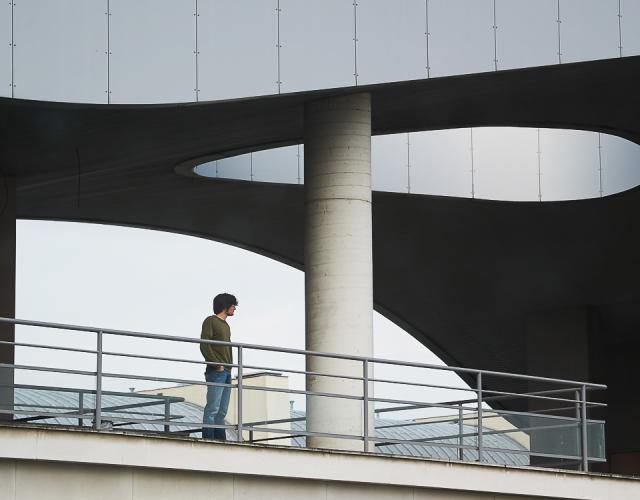
Artist diploma - Interpretation Creation - 3ème Cycle
Information
-
Name
Artist diploma - Interpretation Creation
-
Cycle
3rd Cycle
-
Course's number of years
2 years
-
Delivered diploma
Artist diploma - Interpretation Creation
-
Course objectives and content
Theme 1: Practice
1.01 Solo practice
In-depth study of 20th and 21st century repertoires for soloists, creation of new works.
Consolidation of instrumental techniques related to these repertoires.
1.02 Chamber music practice
In-depth study of 20th and 21st century repertoire for non-directed ensemble, creation of works.
1.03 Conducted ensemble music practice
In-depth study of 20th and 21st century conducted ensemble repertoire, creation of works.
1.04 Performance of electroacoustic and mixed repertoire
Work on the electroacoustic and mixed repertoires, in conjunction with the Métiers du son department and the Audiovisual Department.
Experimentation and creation within the facilities of the Conservatoire and its partners.
1.05 Introduction to generative improvisation
Discovery of generative improvisation and reflection on this practice in relation to 20th and 21st century repertoires and electroacoustic and mixed music.
Area 2: Knowledge and research
2.01 Knowledge of 20th and 21st century repertoires
Through practice and theory (workshops, lectures, etc.), development of a historically informed interpretative approach to these repertoires, through a critical approach to sources and performance traditions.
2.02 Interfaces and creation
Introduction to technologies in order to facilitate dialogue between computer music producers and performers and to empower the latter with regard to technological tools.
2.03 Knowledge of the contemporary music ecosystem
Knowledge of distribution networks and players in the field.
2.04 Research
Participation in the development and writing of a joint research project.
Area 3: Transmission
3.01 Introduction to mediation
Raising awareness of mediation tools and issues specific to the repertoires of the 20th and 21st centuries and to new works.
3.02 Mediation project
Implementation of a mediation project, in groups and semi-autonomously.
Axis 4: Professionalisation
4.01 Knowledge of the creative process
Regular work with composers and players in the field.
Creation and dissemination of works.4.02 Knowledge of stage professions, project design and production set-up
Workshops with guest speakers and the Conservatoire's resource departments.
4.03 Preparation for competitions and auditions
Work sessions and mock competitions.
-
Number of complementary disciplines to validate
0
Disciplines
Entrance exam
Artist diploma - Interpretation Creation
Opening date for registration : 01 April 2026
Closing date for registration : 15 May 2026
Exam dates : Présélection sur vidéo : mai-1er juin 2026. Admission au CNSMDP : début septembre 2026
Important: Non-EU candidates must apply for a short-stay “competition” visa in order to take part in the entrance examinations. If successful, this visa will then allow you to apply for a student visa. You should not apply for a tourist visa. More information here
Visa
Non-EU candidates must apply for a short-stay “competition” visa in order to take part in the entrance examinations. If successful, this visa will then allow you to apply for a student visa. You should not apply for a tourist visa. More information here
Diploma requirement
This audition is open to candidates who hold a master's degree from a higher music education institution.
Preselection
Applicants must submit, before the deadline (June 1, 2026), a set of videos including the following programme*:
- a free programme of works dating from before 1945, lasting between 10 and 15 minutes ;
- a free programme of works dating from after 1945, with or without electronics, lasting between 10 and 15 minutes, including a work or excerpt from a work to be chosen from a compulsory list (the list will be disclosed before February).
* for percussion: a 30-minute programme from the set list or of similar difficulty (see list).
Candidates must also send a portfolio including :
- a curriculum vitae ;
- a letter of motivation.
If the number of applications is insufficient, the Conservatoire reserves the right to extend the submission deadline.
Candidates may submit pre-existing videos.
Instructions for submitting the dossier will be sent after payment of the registration fee.
Admission (September)
- a semi-directed collective examination (30 minutes);
- performance of a work or excerpt from a work of your choice, composed after 1950, without electronics (between 7 and 10 minutes). Solo works are recommended;
- an orchestral excerpt examination (max. 10 minutes);
- a 15-minute interview, in French or English, covering:
- critical feedback on the collective examination;
- academic and professional background;
- motivation;
- professional project;
- ability to work within a collective.
Description of the semi-directed collective examination
Candidates are divided into groups of about ten and take part in a half-hour improvisation session, semi-directed by a Conservatoire teacher.
The jury observes the interactions between candidates, their ability to make musically relevant proposals, their creativity, and their imagination when facing the challenges posed.
Description of the orchestral line test
Each candidate is placed in isolation for 10 minutes with a required orchestral excerpt, drawn from the 20th- or 21st-century repertoire.
At the end of this preparation, the candidate plays the excerpt once, then is asked to repeat it while following the indications of a jury member.
For singers, this examination may instead be based on an excerpt from a solo or chamber work of the 20th or 21st century.
For the repertoire examination, candidates may be accompanied by musicians of their choice. The Conservatoire does not provide accompanists.
Maximum age : 30
